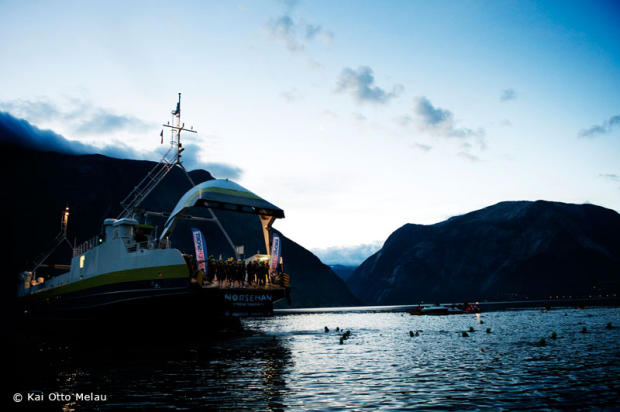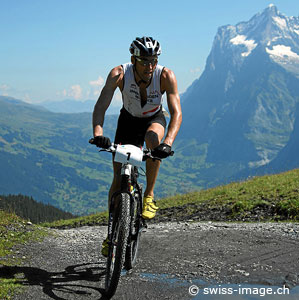Meet SavageMan Kyle Yost
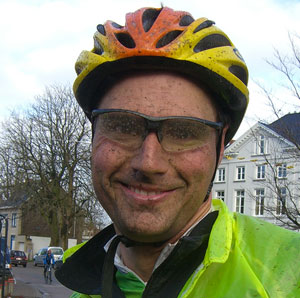
The SavageMan triathlon has gotten a lot of interest over a relatively short period of time, with images of folks struggling up the Westernport Wall proving that tough event point. Slowtwitch had a few words with SavageMan founder Kyle Yost.
Slowtwitch: Kyle first of course thanks for your time.
Kyle: The pleasure is all mine.
ST: How did the idea for the race come up and can you claim all the credit?
Kyle: I can take credit for the fact that SavageMan exists. But I certainly cannot claim credit for its success, as SavageMan has been a labor of love from many parties and a venture that the local community has thoroughly embraced.
SavageMan is held at Deep Creek Lake in the Appalachian Mountains tucked in the very western corner of Maryland. Deep Creek Lake is a popular mid-Atlantic vacation destination, and in the early 2000s I had friends with a lake house there, and, as often as possible, I would hop in the car with bike on roof to get out of Washington, DC to go train in the mountains. My friends would take a cooler of beer and go water-skiing and I would take out my old road bike with 42/23 gearing and go throttle myself in the hills. I’ve always loved to explore and find new roads to ride, so I would pack a map, plot out a route, and hope for the best. And, what I learned – besides that 42/23 is insufficient gearing for the hills out there – is that once you get about 2 miles away from the lake that you are deep in rural Appalachia and the riding is phenomenal – beyond phenomenal, it ranked high amongst the best I’ve experienced and I’ve ridden all over the world. Before long I was bringing out my tri training partners and we would rent a house for a week at Deep Creek Lake for excessive Epic Camp like training. It was during one of these training weeks that everyone agreed the area was just too perfect to not have a triathlon there. And the name was unanimous; it had to be called SavageMan, for the crossing of Big Savage Mountain, for the ride through Savage River State Forest along the Savage River, and because it would without doubt be the most savage triathlon on the planet. And, thus the idea for SavageMan was spawned and the 0th Annual SavageMan trial version followed shortly thereafter.
ST: The 2011 SavageMan will be 5th official edition of the event, or do you count the 0th Annual version from 2006?
Kyle: Ha, the 0th Annual SavageMan, how did you learn about that? The 0th Annual was invitation only and a chance for members of my Washington, DC area triathlon club to have a season-ending weekend club getaway and to give feedback on whether they thought the region and the course I designed would make for a good triathlon.
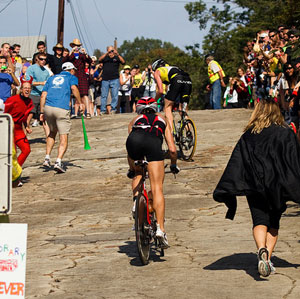
The 0th Annual was also a very fortuitous weekend, as it was then that I met Greg Safko, the President of the Joanna M Nicolay Melanoma Foundation. Greg and I joined forces that weekend and have worked very closely together on making SavageMan a success ever since. We have a symbiotic relationship in which the Melanoma Foundation receives 100% of the proceeds from SavageMan and furthers its very related mission to fight skin cancer, and I have a partner willing to pursue my vision of SavageMan as a race in which maximizing the participant experience trumps all other concerns.
ST: Explain that relationship with the Melanoma Foundation.
Kyle: 100% of all registration and fundraising proceeds from SavageMan and the Garrett County Gran Fondo go to the Joanna M Nicolay Melanoma Foundation, “the voice of melanoma prevention, detection, and cure.” As such, registration fees are actually tax-deductible charitable donations, which make an already affordable race even more so and supports the Foundation’s important education, research, and advocacy initiatives. Participants are encouraged to fundraise and are provided with a personalized fundraising page with registration, but fundraising is not required in order to race.
ST: Are you amazed how much talk there is now about the event?
Kyle: Without doubt I enjoy all the talk and the positive feedback that participants have to say about the event. But, no, it does not surprise me. I’ve been a triathlete since 1998 and I have raced the gamut of events, from pool swim sprints to international Ironmans and world championships. I knew that the venue and the terrain of SavageMan would make it a classic “bucket list” race unless we did something stupid to screw it up like compromise on the bike course to make it easier to staff or took other management shortcuts that would diminish from the overall experience.
SavageMan’s notoriety has spread almost exclusively by positive word of mouth advertising. As an example, the inaugural year a lone soul from Ottawa somehow heard of SavageMan and made the 10-hour journey. The next year he came back with about six friends. In 2009 there were 12. This year probably 20 folks from Ottawa made the journey. It’s a long haul from Ottawa and they have plenty of closer races to choose from, such as Demi Esprit, Muskoka 70.3, and Syracuse 70.3, but each year the Ottawans return home from SavageMan glowing about the event and bringing back a larger crowd the next year. And, Olivier, the original Ottawan, is now one of just nine with a brick in the Wall for every SavageMan.
SavageMan has sold out each of the last two years and is on pace for a much more rapid sellout this year. This is too bad and I hate that people who want to race will inevitably get shut out, but the roads are narrow and the descents technical, so the field must be kept small.
ST: There are other challenging courses out there but what sets the SavageMan apart?
Kyle: First of all, SavageMan is the toughest of the tough. There will be endless debate on the internet about what race is harder than which, but no one who has done SavageMan ever claims there is another tougher. While the bike course gets all the attention, the run is a real challenge, too. We offer a money-back guarantee to anyone who feels they have raced a more challenging course, but no one has asked for a refund yet.
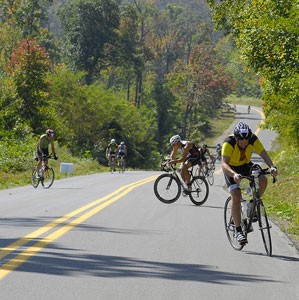
But, really, when it comes to what makes SavageMan different, it comes down to why SavageMan even exists in the first place. Most events exist as a means to raise money either for a profitable venture or charity, or because there is a paucity of events in a region and supply and demand dictates someone step in with a new event to increase supply. Neither of these were reasons behind SavageMan’s creation. I was not interested in making money off of triathlon or in event management, and multi-sport athletes were not banging down the door begging for an event to be created in rural western Maryland. SavageMan was created simply because the venue, and in particular the roads and severe climbs for the bike course, were simply too wonderful for an event to not exist there, and as a passionate triathlete I strove to bring to triathletes that which they did not yet realize they were missing.
Finally, in line with our “participant experience first” mission, we strive to really put on an event that stands above all the rest, and I think that effort has paid off. In addition to the truly unique award of a personalized brick laid in the road for all who clear the Westernport Wall cleanly and go on to finish the race, we try to go the extra mile with many little things that the athletes and families alike appreciate. For example: free spectator buses to the Westernport Wall block party, excellent food and ice cream at finish, extensive and useful schwag like arm warmers, a well-staffed, well-marked and accurately marked course, an average of over 40 race photos per athlete offered for sale well below market rates, a bike course littered with encouraging and humorous (some may say mocking) signs such as “Who’s Making Fun of Triples Now?” on a 20% grade, themed aid stations full of costumed volunteers, a race-within-a-race with timing and prizes for the 7.1 mile ascent of Big Savage Mountain, and more.
ST: Did you expect the Westernport Wall to become the classic climb in triathlon that it has become?
Kyle: I knew we had something special on our hands with the Westernport Wall, a 31% competitive differentiator that other events couldn’t replicate even if they wanted to. As of race day on the first year we had not even come up with the idea for the engraved bricks laid into the road surface yet, and we just told racers that everyone who got up clean would get a “true savage” prize, which was a bumper sticker trumpeting their accomplishment. Deciding that was kind of lame, my wife suggested the bricks in the road idea, which both Greg and I jumped on as brilliant. Expensive, but brilliant. We’ve gone from 46 bricks earned in 2007 to 253 in 2010, so we’ll run out of road space before too long at this rate!
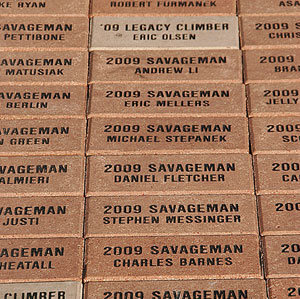
So, the Westernport Wall has been a huge marketing boon for us. How many races is there a realistic chance that you will fall off your bike? How many races give you the opportunity to be immortalized with a brick with your name laid into the road surface itself? How many races will you have trident wielding devils screaming in your ear treating you like a Tour de France mountains champion? SavageMan and the Westernport Wall is truly a unique experience in all of triathlon, and it’s pretty neat to be a part of that.
The irony is that so many participants think SavageMan is all about the Westernport Wall, and don’t realize that the Wall is just the start of a ridiculous day of climbing and that the vast majority of SavageMan’s 5700 feet of climbing will be coming at them in the next 25 miles. Ask any SavageMan finisher about Westernport and they’ll quote you a sign on the course around mile 40: “Westernport Schmesternport. Welcome to Killer Miller.”
ST: Do you handle some other races too?
Kyle: SavageMan is the only triathlon I am involved with. Greg and the Melanoma Foundation organize a pool swim sprint triathlon and a kids triathlon to also further their mission, but SavageMan is far and away the premier event.
Greg and I also put on the Garrett County Gran Fondo in the same area as SavageMan. The Gran Fondo includes four rides, but the flagship is the Diabolical Double Metric, a 125-mile soul crusher that includes 16,000 feet of climbing and was included in Rapha Continental’s tour of the top 25 epic rides in North America. Having personally ridden extensively in the Alps and Pyrenees, including the entire 2007 Tour de France one week before the race, I can vouch that the Diabolical Double can stand toe-to-toe with any single day epic ride, including the Queen stage of Le Tour. I consider it La Marmotte of North America.
ST: But you are not a fulltime race director?
Kyle: Oh no. I’m not even a race director for SavageMan; I leave that to Greg and the staff of the Joanna M Nicolay Melanoma Foundation. My work with SavageMan revolves around the course design and maintaining the mission of “participant experience first”, in addition to all technical details such as the website, registration and fundraising sites, and the searchable photo library. Greg and I have a great working relationship. SavageMan brings in a lot of money for the Melanoma Foundation, and he completely agrees that SavageMan’s number one priority should be about the experience, not be about maximizing the money.
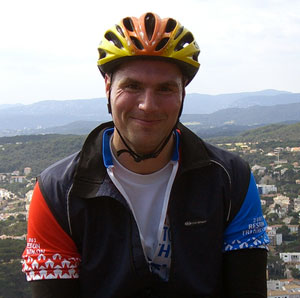
ST: So no plans to sell the event to a bigger organization?
Kyle: I would be very surprised if that were to happen. As I’ve mentioned, the primary mission of SavageMan is to put the participants experience first, which very likely conflicts with a larger organizations mission to maximize profit. Additionally, SavageMan will never be a large race as the venue and the roads cannot support it, so a large organization likely would not be interested when the growth potential is so limited. I don’t think you’ll see SavageMan changing hands anytime soon.
ST: Will you have a chance to do SavageMan anytime soon?
Kyle: I sure hope so. My wife has done it twice and even my unborn daughter finished SavageMan this year! My wife has her brick in the Westernport Wall and I want my own. It won’t be too many years before we’re out of road space for laying bricks, so I’ve got to get mine and soon.
ST: Is there anything else we should know?
Kyle: Well, it’s probably worth clarifying that SavageMan has two races over the weekend, the SavageMan 30.0 (0.9, 22.9, 6.2) and the SavageMan 70.0 (1.2, 55.7, 13.1), and for the real savages out there who want to do both, the SavageMan 100.0. The SavageMan 70.0 is the flagship race that includes the Westernport Wall and is the race we’ve been discussing in this interview. But, folks should know that the 30.0 distance race exists, too, and while a tough course in it’s own right is not nearly so extreme as the SavageMan 70.0, the World’s Most Savage Triathlon!
Thanks for the interview, Slowtwitch. It was a pleasure! Hope to see some slowtwitchers test their inner savage this fall!
The event website is: savagemantri.org



